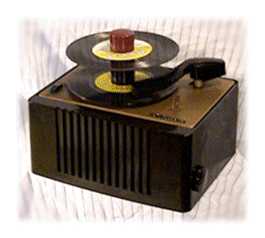
My RCA 45 RPM Record Player web page has drawn several questions about what repairs I did and what parts I used to get the RCA 45 RPM player to work. I'm putting the answers to those questions on this page for all to see.
The most frequently asked question is about the cartridge that changes the mechanical modulation in the grooves into an electrical signal. A purist would search for the exact part. This player had what I believe to be the original cartridge but the stylus was broken off completely. A setscrew at the front held a shaft that used to have a lever pointing forward to hold the stylus tip. The cartridge was a long thin flat aluminum case with two pins for the electrical connections at the rear. Old catalogs show it as a crystal type.
Scratching the stub of the stylus assembly shaft produced sound, proving the cartridge did work, but a quick search did not turn up a replacement stylus. I did not make any effort to locate the original cartridge.
I decided to find which readily available modern cartridge would fit. The modern electrical equivalent to the crystal is called "ceramic". The operating principle, piezo electric, and the electrical parameters are very much the same for both crystal and ceramic. Both are a capacitive source impedance requiring a very high amplifier input impedance, so there would be no change required to the amplifier input. Both types are mechanically equalized, so no other changes to the amplifier were needed either. The sound quality of the ceramic is rumored to be somewhat better than the crystal, but have never seen any data proving that. That is any ceramic that will fit in the arm would do fine.
The best mechanical fit appeared to be a generic replacement type, listed as a replacement for a Varco TN4B and Panasonic CZ-680-6C. At the time I bought one from Premium Parts + but they are no longer in business. As of late 2012 I find this part listed at MAT Electronics.
The new ceramic is made of plastic and has a nifty bracket that the cartridge snaps into. This made the mounting easy, as you don't have to handle the delicate cartridge while fitting it. The snap feature also makes for easy replacement at a future date. The new cartridge has standard mounting screw locations but the old RCA does not. This meant I had to trim the bracket to accept the mounting screws in a location that would hold the stylus tip at the original location.
The plastic cased ceramic is much lighter than the old cartridge. I added weight experimentally to the front of the arm to find what gave enough force to make the new cartridge track well. I measured the force with a stylus force gauge and glued the best weight inside the arm.
The ceramic is a stereo cartridge. I wired the two sections in series to add the left and right outputs. If you do this and aren't sure which pin is which, the connection that plays loudest on a monophonic record is correct.